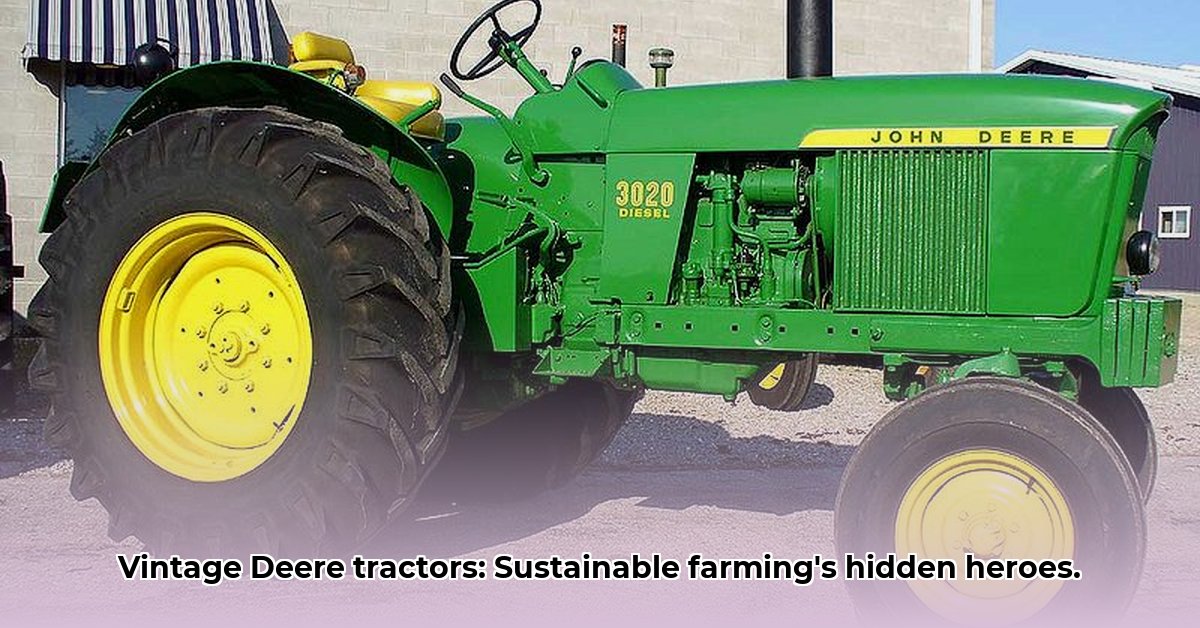
The rumble of a vintage John Deere tractor—a sound synonymous with American agriculture—evokes a rich history of innovation and transformation. These iconic green machines didn't merely change farming practices; they fundamentally reshaped rural life and the global food supply. However, their legacy extends beyond horsepower and steel, encompassing a complex interplay of efficiency, environmental impact, and economic accessibility. This article explores the historical journey of John Deere tractors, analyzing their contributions to agricultural productivity while acknowledging the crucial need for sustainable practices in modern farming. For more information on classic models, check out this site on vintage John Deere tractors.
The Green Giants' Rise to Prominence
John Deere's journey began not with tractors, but with the 1837 invention of a revolutionary self-scouring steel plow. Before this innovation, farmers struggled with the heavy, clay-rich soils of the American Midwest. Deere's plow, a simple yet groundbreaking design, effortlessly cut through the earth, laying the cornerstone for the company's future dominance. The subsequent transition from animal power to internal combustion engines in the early 20th century marked another watershed moment. Early John Deere tractors, rudimentary by today's standards, revolutionized farming, liberating farmers from the backbreaking labor of horses and oxen.
A Technological Revolution in the Fields
Imagine the immense physical exertion required to till a field by hand or even with animal power. Early John Deere tractors rendered this unimaginable. The machines weren't just about horsepower; they embodied a paradigm shift in farming. A single farmer could cultivate acres in a day that once took weeks. This efficiency surge led to dramatically larger harvests, feeding a burgeoning global population. The economic impact was transformative, restructuring rural power dynamics and boosting overall productivity. Fewer people could produce exponentially more food, generating cascading effects throughout the national economy. How did this technological leap affect the day-to-day life of the average farmer? Did it lead to increased prosperity, or did it create new challenges? The answer lies in a multifaceted examination of both opportunities and difficulties.
| Tractor Model | Approximate Year | Key Innovation | Impact on Efficiency |
|---|---|---|---|
| Model "A" | 1920s-1930s | Reliable workhorse; widespread farm adoption | Significantly increased output; user-friendly operation. |
| Model "B" | 1930s-1940s | Enhanced power and features; improved reliability | Further efficiency gains and reduced downtime. |
| Model "D" | 1940s-1950s | Streamlined design; improved fuel efficiency | More efficient fuel usage; increased yields. |
| 4020 | 1960s | High horsepower; versatile across various crops | Revolutionized large-scale farming; massive output increase. |
| 9620RX (Modern Example) | Present Day | Cutting-edge technology; exceptional power and precision | Maximal productivity; enhanced precision agriculture. |
The Environmental Footprint: A Necessary Consideration
While the efficiency gains of early John Deere tractors are undeniable, their environmental consequences demand careful consideration. The production of these machines consumed significant resources – steel, fuel, and various other materials. Their operation, particularly in the early models, resulted in substantial fuel consumption and emissions. While instrumental in feeding the world, their legacy necessitates a critical assessment of their role in contemporary sustainable agriculture. This involves a balanced perspective – acknowledging their historical necessity while advocating for more environmentally conscious design and practices. How can we balance the need for efficient food production with the urgent need to protect our planet?
Economic Accessibility: A Modern Challenge
The high cost of even older John Deere tractors, and especially modern models, presents a significant barrier to entry for many smaller farms. This economic disparity favors larger operations, potentially marginalizing smaller, family-run farms. This raises concerns about the equitable distribution of agricultural technology and the long-term sustainability of farming as a viable livelihood for a diverse range of producers. Addressing this challenge requires exploring solutions such as government subsidies, cooperative ownership models, and investing in more affordable, sustainable technologies. How can we ensure that technological advancements benefit all farmers, not just the largest ones?
The Future of Farming: Balancing Progress and Sustainability
The legacy of old John Deere tractors is complex. Their contribution to agricultural efficiency is undeniable, yet their environmental and economic impact warrants careful consideration. The future of sustainable agriculture hinges on integrating technological advancements with environmental stewardship and economic equity. This involves exploring alternative fuels, designing more efficient machinery, and developing support systems that empower smaller farmers. The ongoing research into sustainable farming practices signals that this is a continuous journey. It involves not only technological innovation but also a fundamental re-evaluation of agriculture's role within the broader ecosystem. How can the agricultural industry navigate this path – ensuring both productivity and planetary health?
Core Insights:
- The evolution of John Deere tractors significantly increased agricultural efficiency but also came with environmental trade-offs.
- Modern precision agriculture technologies offer a path toward more sustainable farming, yet wide adoption requires investment and collaboration.
- Addressing economic inequalities in agricultural technology is crucial for ensuring the long-term viability of small farms and farmers.